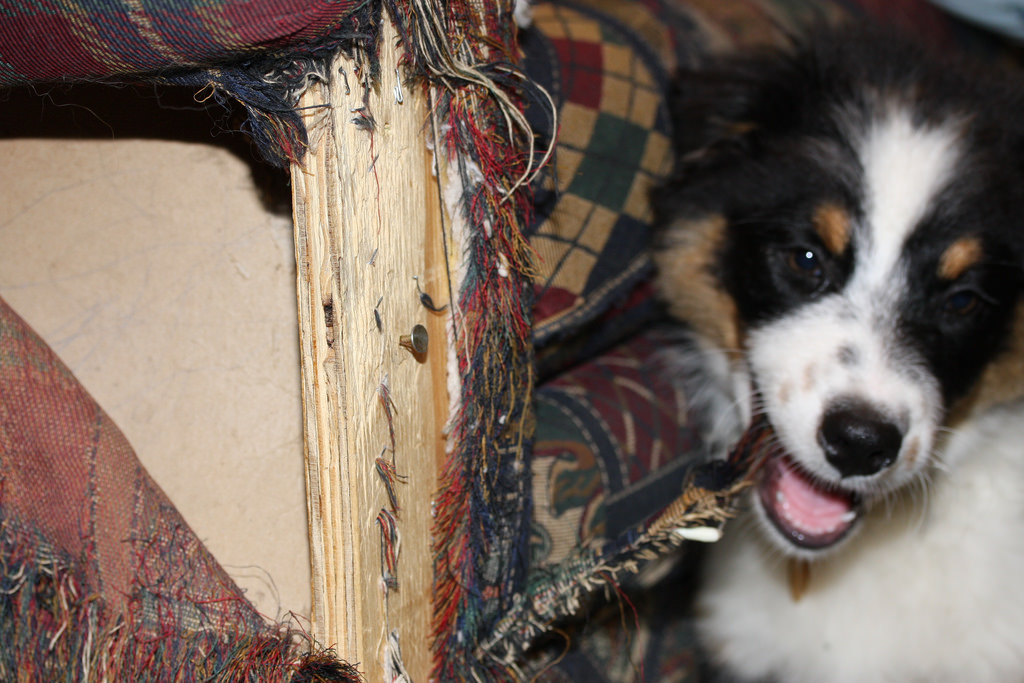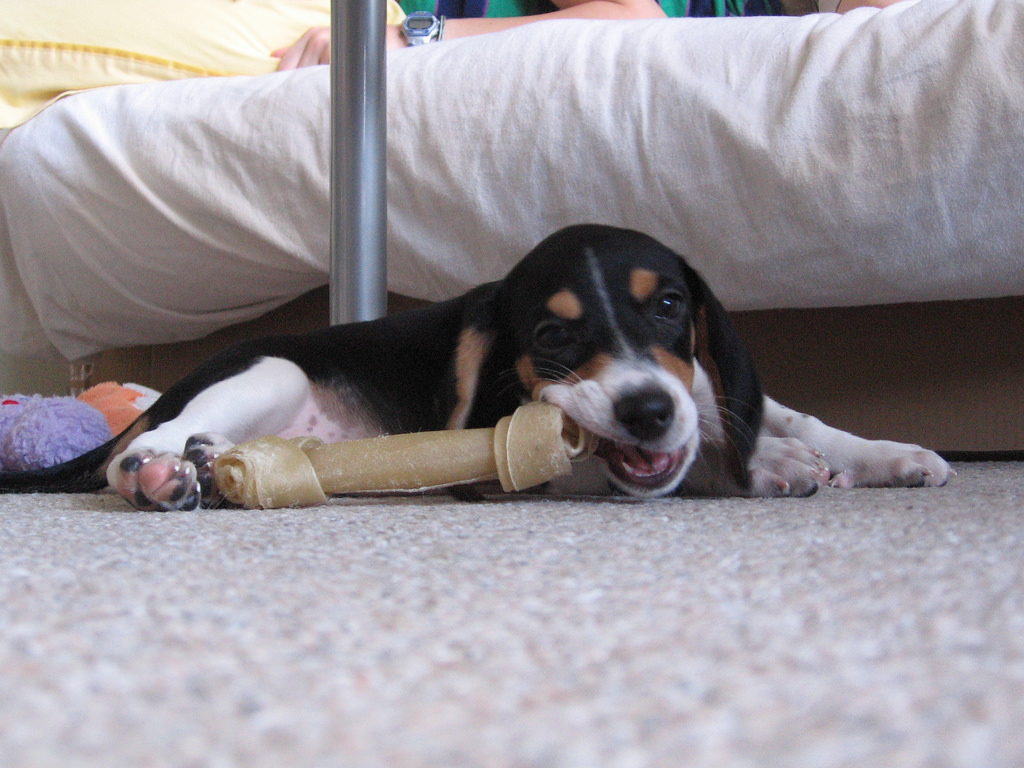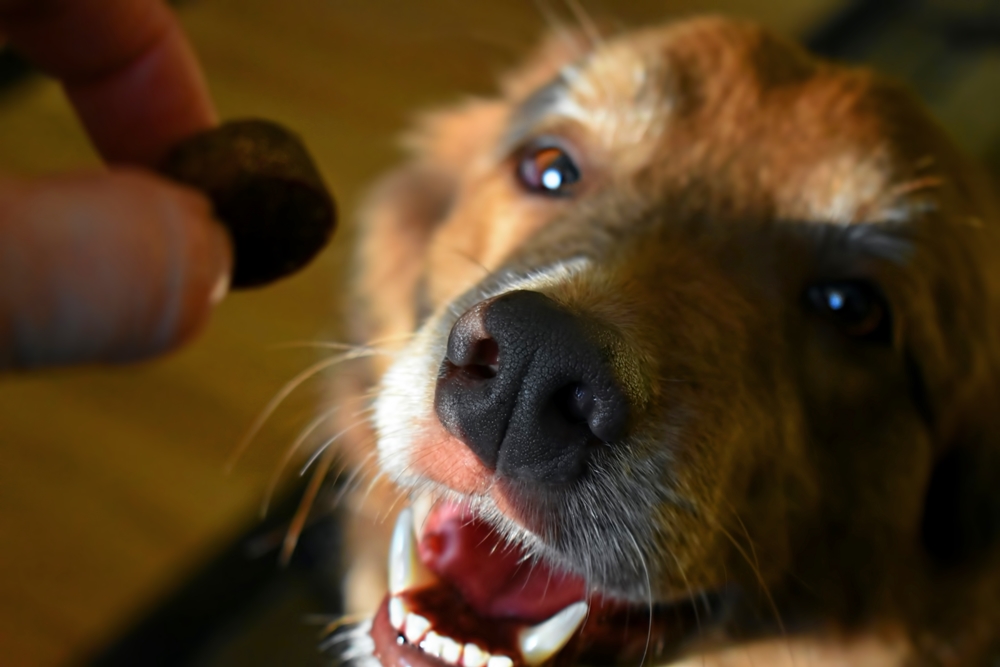How to stop your dog from chewing on furniture

We’ve all heard the nightmarish stories of someone coming home to find that the stuffing from their couch has been chewed up and strewn all over the house.
Or worse, that one of their heirloom wooden dinner tables has had the legs chewed out from under it.
Not all chewing ends up as a complete disaster, but it’s best to avoid it completely.
Luckily for you, we have you covered with all of the training methods and tips you’re going to need to stop your dog from destroying your furniture. Here’s what we are going to lay out:
First, we’ll talk about why dogs chew on things and what problems can arise from chewing even if they aren’t destroying your house. Then, we’ll talk about three strategies to prevent chewing, and finally, we’ll talk about training techniques you can use if your dog has a serious chewing problem and a few other things you’ll want to know.
Why do dogs chew?
Dogs can chew for a variety of reasons. Here are a few of them, but you should talk to your veterinarian if you feel your dog’s chewing is out of control.
Instinct
According to the ASPCA, dogs have a very strong instinct to chew and often don’t have an adequate outlet through which to relieve this biologically ingrained behavior.
Most of the food humans eat is processed, cooked, aged or broken down in some way to make it easier for us to chew and swallow. Dogs, on the other hand, descended from wolves and are designed to eat raw meat. In fact, the design of their teeth specifically reflects an evolutionary history of eating meat.
Another interesting thing to note is the scientific classification for dogs and wolves, canis, is in part a reference to the prominent commonality in their teeth.
Just imagine the sheer amount of biting power a wolf has to have break down raw meat. A lot of connective tissue, tendons and ligaments have to be ripped away in order to eat it.
That may not be a very nice thought, but it does give you an idea of how a dog’s jaw has evolved and why eating their serving of kibble every day may not cut it for them.
Chewing is natural for them, and the best way to deal it is to teach them to chew on the right things from the moment they enter your life.
Rawhide bones, pig ears and chew toys are the most popular options and almost all dogs will love one of them – you just have to find out which your dog prefers and how to safely pick toys, as we’ll explain below. The most foolproof way to stop your dog from chewing is to be proactive and to address the issue when they are a puppy.
Teeth cleaning
Canines have powerful jaws, which is why they have such a strong ability to chew everything in sight – but that’s not always a bad thing. Chewing also helps to clean your dog’s teeth, so it’s important to make sure they’re chewing in a healthy way.
Check out our complete guide on how to take care of your dog’s dental health here!
Things like rawhides and dried pig ears can be swallowed whole depending on the size of your dog and the size of the chew, posing a choking hazard. That doesn’t mean you can never give them to your dog, according to Dr. Patty Khuly, VMD, although she doesn’t recommend it.
If you do choose to give your dog something like that, just make sure to keep a close eye on them until the rawhide is soft, but a better option is to provide treats and toys specifically meant for dental health.
Whether you’re choosing between chew toys that are specifically meant to help with your dog’s dental hygiene or more natural options, just make sure to use your best judgment based on your dog’s size and chewing habits.
My dog chews bark, twigs, sticks and even logs on a daily basis and her teeth are impeccably clean, despite the fact that I have never once brushed them.
My dog is a very outgoing Lab, though, and she loves to explore the outdoors, so chewing on wood to keep her teeth clean is part of her routine. If your dog isn’t as outgoing or you live in an urban environment you should definitely consider brushing your dog’s teeth on a regular basis. You can refer to our complete teeth-cleaning guide for more information on that.
Medical problems
You also want to rule out the possibility that your dog’s chewing is a manifestation of a nutritional deficiency or gastrointestinal problem as these can also cause the dog to chew excessively. For that reason you’ll want to schedule an appointment with your vet and tell them that your dog is chewing on everything.

Be sure to keep an eye on what your dog is chewing! Image: Natasha C Dunn
Methods to deal with excessive chewing
So, we know that chewing is natural for dogs and we know that some amount of it is healthy, but what do you do when your pup starts tearing up the house?
There are a couple of strategies you can try.
Get your dog more exercise
As dog owners, we need to understand that some breeds of dog are stronger, more resilient and simply require more exercise than other breeds. And some dogs just have more energy than others!
For instance, if you have a Jack Russel terrier or an Australian sheep dog and they spend most of their time indoors, they probably aren’t exercising as much as they would like to and might take that excess energy out on your poor coffee table. I had this happen to me with my Labrador retriever when she was a puppy. I wasn’t giving her enough exercise and I knew it was on me to change that.
Methods of exercise
Teaching your dog to fetch if they don’t know already is a very easy way to wear them out with minimal time and effort from you. If your dog refuses to learn or simply does not like to fetch, you’ll have to find other ways of getting them to run a lot. Unless you are a marathon runner, many dogs will need to be off leash for you to effectively tire them out. Try finding hiking trails or dog parks where dogs are allowed to be off leash and let them run and play with other dogs.
If your dog loves to swim, you can take them to rivers and lakes. Fetching comes in handy here, too.
Train them to chew on other things
There are a lot of different schools of thought on the best way to train your dog, but we believe that positive reinforcement is the most effective method.
This methodology employs only rewards as a means to training your dog. We believe in this method for a couple of reasons:
- No one should want to hit their dog, and the good news is that you don’t have to. Many trainers firmly believe that the same outcomes can be achieved through positive training methods as can be achieved with negative training methods (punishment).
- While it’s true that punishments can be effective with some dogs, it will completely shut down others. You don’t want to find this out the hard way.

Training your dog with treats is a great way to stop excessive chewing. Image: Good Day Sunshine
Proactively deal with chewing by providing them with the right things to chew on from your first day with your dog. If you do this, you may never actually have to deal with problematic chewing.
If your dog has begun to chew on the wrong things, spend some time with them and try to catch them doing it. When they are chewing on something they shouldn’t be, simply take it out of their mouth, replace it with a toy or a bone and praise them.
Keep in mind that the key to dog training is patience. You may have to do this dozens of times before the dog begins to understand and change their behavior. Just stick with it.
For more information on positive dog training methods check out The Power of Positive Dog Training by Pat Miller.
Leave your dog in the right places
If you’re going to leave your dog alone for an extended period of time, it’s best if you can leave them in a location where there is nothing to chew on besides their bones and chew toys. This isn’t always possible, but if you have developed good chewing habits with your dog it won’t be as big of an issue as it could be.
If you don’t want to leave your dog in the backyard (or if it’s too hot or too cold), here are some other options:
The kitchen
Instead of sequestering them in your living room where you keep your great grandmother’s heirloom sofa, keep your dog in the kitchen, where you can buy new stools on Ikea for $20 if the cute little bugger takes a liking to their wooden legs.
The bathroom
If your dog is small enough and your bathroom is large enough, you can give the bathroom a try, as it probably has even less to chew on.
Their crate
This is probably the only surefire way to deal with a dog that simply refuses to stop chewing on the wrong things.
Note on chewing sprays: People often ask me about chewing sprays. I have heard that they can be effective in stopping a dog from chewing on a particular piece of furniture. However, there are a lot of drawbacks such as smell, potential damage to the furniture, application being necessary every time that you leave the house and the fact that you haven’t actually solved the problem, you’ve only put a bandaid on it.
What about teething puppies?
To some degree, there isn’t much that you can do about a teething puppy. They will chew everything that they can get their mouth around, and I mean everything. My dog, Maybell, even ended up tearing apart a book called Don’t Shoot The Dog! by Karen Pryor. How ironic, right?
Puppies start teething around 5 weeks old and their teeth are entirely permanent by around 6 months, so if they are much older than 6 months and still chew on everything, you know the problem is not teething.
Advice for teething puppies is the same as it is for older dogs:
- Make sure it isn’t a medical problem
- Get adequate exercise/playtime
- Train them to chew on other things
- Leave them alone in places that they can’t get into trouble
Dogs that use your personal belongings as chew toys can be challenging, but they usually just need to be trained on what is appropriate to chew on and what should be left alone. Additionally, make sure your dog is getting plenty of exercise so they don’t act out and talk to your vet if the chewing remains a problem.
-William B.
Will is an avid dog lover, writer and explorer. He grew up in Montana and started training hunting dogs from a young age. Now he’s left his roots to travel throughout South America while he focuses on his writing career.
Feature Image: carterse
